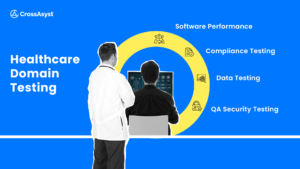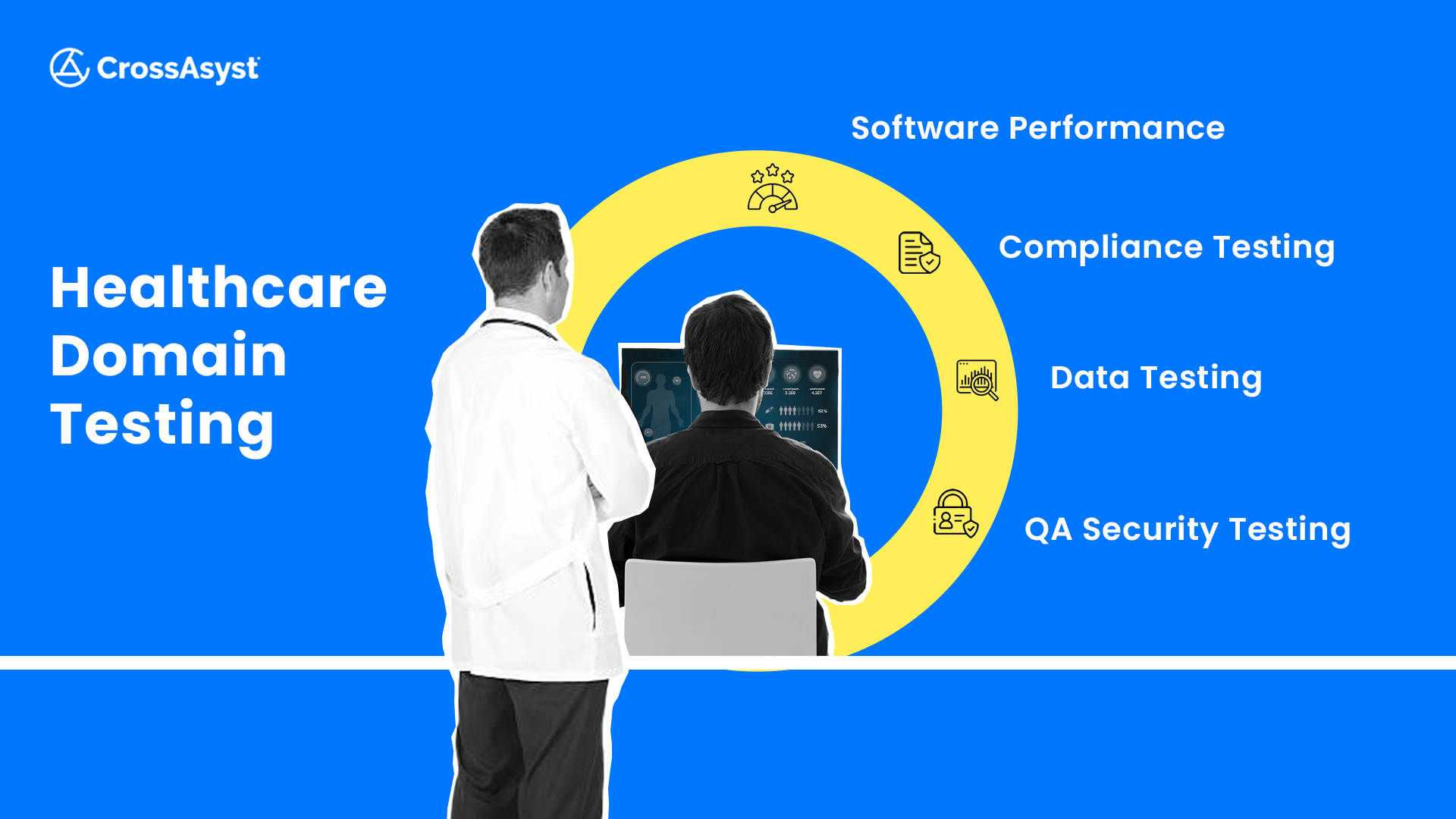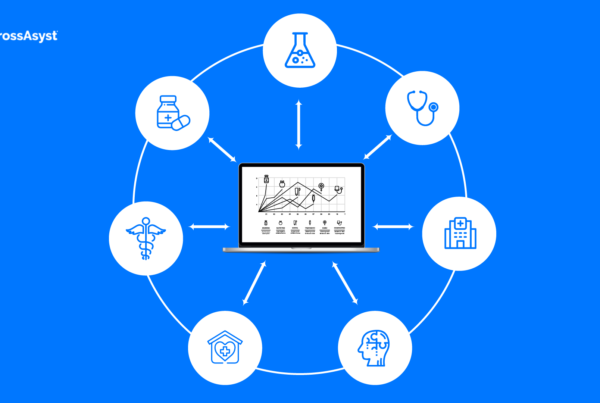
Technology has always played a huge role in the healthcare industry, but that role has grown exponentially since the outbreak of the global Covid pandemic. Healthcare software is now responsible for multiple critical functions, ranging from remote monitoring and maintenance of electronic health records (EHR) to hospital administration and more.
As in the case of other software applications, healthcare software applications also need to undergo testing before they are deployed. However, in this case, there are specific compliances and regulations that need to be met before an application is cleared to be used by the software industry.
Here’s a quick look at the scope and importance of healthcare domain testing to give us a better understanding of what areas are covered under healthcare software testing, why it is important, the challenges in the process, and more.
Table of Contents
What is Healthcare Domain Testing?
Simply put, healthcare domain testing is the process of testing healthcare software applications to ensure that they are compliant with the necessary regulations and meet the requirements of end users.
These requirements include data security, management of healthcare records, administrative functions, such as billing, and more.
In addition to technical knowledge of the application being tested, healthcare domain testing requires a thorough understanding of the unique needs and complexities of the healthcare industry, such as the need for additional data security and laws related to data privacy.
Healthcare software testing is an essential part of the development process of every software application used by the healthcare industry, including healthcare web applications, healthcare mobile applications, healthcare desktop applications and medical device software.
Why is Healthcare Domain Testing Important?
Let’s now delve into why healthcare domain testing is such an important aspect of the healthcare software development lifecycle.
1. Increased Efficiency
Healthcare software applications are complex in nature, and need a high level of expertise and efficiency to be able to deliver high quality care to patients. These applications need to operate seamlessly for healthcare professionals to be able to use them optimally.
Healthcare software testing ensures that any snags are detected and rectified before these applications are deployed, enabling increased efficiency and accuracy.
2. Big Data Handling
Considering the average patient generates close to 80 megabytes of data, the amount of data the healthcare industry generates is truly staggering. This data, consisting of patient information, health conditions and more, is crucial to developing treatment plans, research, strategies, and more.
All the necessary data points are extracted, analyzed and presented using Big Data solutions. This makes the testing of these applications imperative, so that they can deliver accurate and dependable data insights to healthcare organizations, ensuring ideal outcomes.
3. Increased Security
Healthcare data is full of important and private information, making it the target of security breaches. In fact, the personal and healthcare data of over 10 million US residents was leaked as recently as the second week of August, 2023.
This makes security testing vital to ensuring applications remain hacker-proof and that sensitive healthcare data is not compromised.
4. Improved User Experience
Usability testing of healthcare software applications ensures that doctors and other healthcare professionals can easily navigate and use these applications, improving the overall patient experience.
Healthcare Domain Testing Best Practices
Here are some healthcare domain testing best practices which, if followed, are guaranteed to provide the best results.

1. Choose The Right Resources
Healthcare software applications often feature complex architecture, multiple detailed workflows and handle vast amounts of data. Therefore, the testing team ought to be one that has a thorough understanding of the healthcare domain and the technology as well.
A software testing team that does not have domain knowledge will likely spend more time trying to understand the technology rather than actually testing it and reporting gaps as well as defects. As a result, the software itself will be deemed unreliable and unsafe.
To avoid this, it is a good idea to ensure the testing team has sufficient experience both with the domain and with testing tools. The team should also be clear about the business logic behind the project and the requirements thereof.
2. Ensure All Requirements Are Met
Healthcare software testing requirements are very different from regular software testing, as are the end users. These end users include healthcare professionals, patients, intermediaries and partners, such as insurance companies, regulatory bodies and more.
The goal of healthcare software testing is to ensure all the requirements of these end users are met. Here are some aspects that healthcare software testing ought to cover.
- Ensure the application can work efficiently even when network conditions are not ideal.
- Ensure that the software is scalable and that its architecture is stable.
- Ensure the security protocols in place can protect the software and the data it holds against malware, hackers and other security threats.
- Ensure the software application is easy for all end users to use.
- Ensure the software is compliant with local regulations, HIPAA and FDA regulations.
3. Pay Attention To Data Security
Data security is of paramount importance in the healthcare industry, and breaches end up costing healthcare organizations hundreds of millions in damage control.
Here are some pro tips to ensure healthcare domain testing covers data security thoroughly.
- Ensure all testers are well-versed in compliance standards as set by HIPAA, ISO, FDA, HL7, DICOM and CMMI. Apply test cases to all of these regulations, depending on the requirements, and ensure the software application is compliant with all of them.
- Do thorough penetration testing to ensure any security gaps are quickly identified and addressed.
4. Build A Comprehensive Testing Protocol
The scope of healthcare software applications is varied, including healthcare administration, document management, medical devices and more. This makes it essential to have a comprehensive domain testing protocol that can cover the entire scope.
Here are some best practices to help healthcare software testing teams achieve that.
- Conduct functional tests to check if the application can transmit data accurately even in less than ideal network conditions.
- Conduct data-driven tests to check if the software is stable and secure even when volumes are higher than normal.
- Validate authentication to test if the security measures in place perform optimally in multiple scenarios.
- Conduct repetitive tests to ensure the software application delivers consistent results irrespective of the number of times and the varied situations in which it is used.
- Run multi-platform verification tests to make sure the software functions optimally on all the devices, platforms and browsers it is meant to be used on.
- Test your team’s agile problem solving capabilities to ensure they are capable of quickly identifying problem areas and addressing them.
5. Employ The Best Of Both Unit and Integrated Testing
The ideal testing process, especially for EHR-related software applications, should be a mix of unit testing and integrated testing.
That way, you can test the efficacy of each individual component of the software application, and also ensure combinations of components also function optimally.
6. Maintain Detailed Documentation
The nature of healthcare domain testing is volatile, with minute changes and tweaks being made to the application continuously based on test results. This makes constant documentation extremely difficult, but also extremely important.
This is because without documentation, there will be no way for the testing team to keep track of versions and the number of changes that have been made to the original application.
On the other hand, a detailed documentation process will ensure that there is enough data to validate the number of tests that the healthcare software has gone through, the outcome of those tests, and vouch for the quality of the final product.
7. Test in Sync With The Development Team
Healthcare software testing should never be conducted in silos. If the testing team works independently of the product development team, there is bound to be a disconnect, resulting in delays in altering the code base and increasing the overall cost of the project.
However, if the development team and the software testing team share the same vision, work and communicate transparently with each other, you can be assured that the testing will be more accurate and vigorous, that issues will be addressed more efficiently, and that the overall quality of the software application will be improved.
Reach Out to CrossAsyst for All Your Healthcare Domain Testing Needs
The CrossAsyst team has over a decade of experience in every aspect of custom software development, including QA and domain testing. A large part of that time period has been spent servicing the unique needs of our healthcare clients. This extensive domain knowledge gives us unmatched insights and expertise in healthcare domain testing.
Our team is well versed in healthcare IT systems such as GE Centricity and AthenaHealth, making them well equipped to test and ensure healthcare software is of the highest standard.
Our team is also HIPAA compliant, which means you can rest assured that your healthcare software will meet all regulatory requirements.
Our testing capabilities include software performance testing, QA security testing, data testing and software compliance testing. By using agile practices and having a strong focus on test automation, our testing team ensures that the testing process is error-free and includes rapid testing cycles and quick feedback loops.
Get in touch with CrossAsyst today, not just for your domain testing needs, but for top-notch, end-to-end custom software development.
Reference – https://www.firstpost.com/tech/news-analysis/us-hit-by-major-cyberattack-hackers-exploit-ibm-steal-over-millions-of-peoples-healthcare-personal-data-12999372.html




